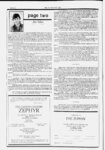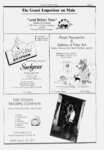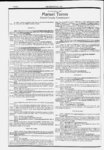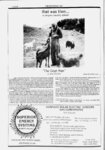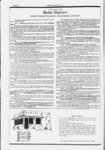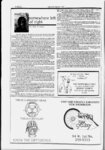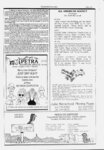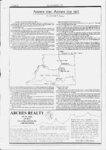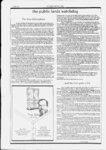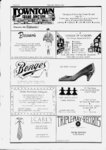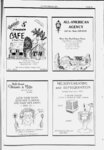| OCR Text |
Show THE ZEPHYRMAY 1991 PAGE 20 the fall & rise of the blackfooted ferret by Damian Fagan The Utah State Division of Wildlife Resources completed extensive surveys for ferrets In the Bouncing across the landscape, biologists spent hours spotlighting areas looking for green eyeshlne that could Indicate ferrets. Green eyeshlne can also mean antelope, weasel or badger. The researchers walked through the prairie dog colonies, mapping them and estimating populations of prairie dogs. Scat, tracks or the characteristic diggings left behind by ferrets were also looked for. Possibilities existed but the searchers did not turn up any ferrets. Wanted Alive Posters were already In place but the reward for sightings leading to the confirmation of a live ferret went up to $10,000. Many people called the DWR office, stating that they saw a ferret and that their bank account number was " Good try. The "we saw one on although we were traveling 75 m.p.h. at the time types of reports usually got canned. The others that contained some details, maybe even a photograph, got Investigated. But still no ferrets. The captive breeding program Is making gains. As the population nears 200 Individuals, there Is talk of reintroducing these animals. Utah ranks high on the list for "Experimental Populations since so much work has already been done. An area near Vernal and one in the Cisco Desert are the two locations targeted for the reintroduction. Tumbleweeds roll down the main street Dust floats In the air. Homes are empty, abandoned, deserted. Silence now lives In this town, along with a couple of mice that scurry about the ruins. A few wilted flowers hang upon brown lifeless stalks. Although this could be the set of a thousand Hollywood movies, It Is unfortunately real. The name of this town Is long since forgotten, and clues about the former occupants are scarce. Except one: the homes they dug Into the ground. Found throughout the western grasslands from Texas to Canada, settlers passed by these towns on their westward migration. From their homes, the Inhabitants greeted these newcomers with barks and whistles. Thinking these animals sounded like their domestic canines, the settlers called these Inhabitants prairie dogs. If the settlers ever had any fondness for these prairie dogs, It was short-live- d. Soon after the wagons rolled across the prairies, the land became divided up, fenced off and plowed under. Settlers became furious because occasionally a cow or horse would break a leg In a prairie dog hole. These settlers Initiated a program to rid the prairies of these rodents and thus to reduce their losses. Poisoning and shooting spread like a prairie fire. Coupled with losing their habitat, populations of prairie dogs plummeted. But they were not the only prairie dwellers to suffer. mid-198- such-and-su- Hardest hit was the black-footferret These ferrets lived among the prairie dogs and used abandoned burrows for their dens. Conducting nighttime forays from their burrows, this relative of the weasel family carried on a rather secretive lifestyle. The ferrets preyed upon the prairie dogs, as well as other rodents, birds and lizards. Never very abundant In the first place, the ferrets could not withstand this eradication program. As the land became more divided, so did the population of ferrets. Eventually only Isolated Individuals or small Inbreeding populations existed. The ferret became the rarest North American mammal. An unpleasant distinction. A discussion about ferrets rarely excluded the word extinction. Red flags went up and though perhaps too late, the search for ferrets began. Then the extraordinary happened In 1981. A colony of ferrets was located on a near Meeteetse, Wyoming. At the time, this was the only known population. ranch private In other areas existed, but this large population gave the wildlife of Individuals Sightings community some hope. The number of ferrets peaked In 1984 at 130 Individuals, Just before their numbers crashed because of an outbreak of canine distemper (a virus spread by domestic dogs). Heated debate and finger pointing followed this outbreak. Science and scientists faced the proverbial chopping block. In their attempts to save these ferrets, the researchers had caused their demise by allowing dogs to enter Into the prairie dog towns. In 1986, took the final 15 ferrets. A captive breeding program began In attempts to rebuild the population. If successful, these populations of ferrets would be returned to the wild. Approximately ed live-trapp- 0s. 20 to 25 ferrets could be released, a large enough population to avoid Inbreeding. The history of western settlement Is stained with the blood of many animals. The the wolf, the buffalo, the passenger pigeon, are Just a few of the animals our grizzly, ancestors sentenced to death. History continues today as predators face a stacked Jury. With the ferret comes a chance for redemption, a chance to undo old wrongs. The word ferret originates from an Old French word, furlet which means thief (In reference to Its black mask). Unjustly punished, the ferrets committed no crime; It was we who stole from them. Since prairie dogs look similar to a ferret (especially at 75 m.p.h.) care must be taken to avoid confusing the two. Ferrets have a distinctive dark mask around the eyes, like an opera mask. Their legs and the tips of their tails are black also. The general body color Is buckskin, with a darker brown coloration on the saddle of the back. The eyeshlne Is are Ferrets but of certain times the year they are active In the day. green. nocturnal, during Any sightings should be reported to the Division of Wildlife Resources, In Price, Utah, at 0. A potential reward exists. 637-331- ing WMtti FROM I 74 South Main o Moab, Utah o 259-SUB- ch. S 1 WANT A MyTMtf op to it $u CUW&fc H0MAMJ Att OP t ?ME GIAMT TtFPfittS, |

